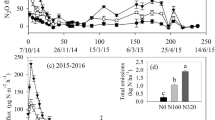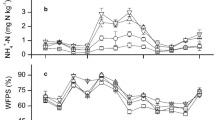Abstract
Microbial respiratory reduction of nitrous oxide (N2O) to dinitrogen (N2) via denitrification plays a key role within the global N-cycle since it is the most important process for converting reactive nitrogen back into inert molecular N2. However, due to methodological constraints, we still lack a comprehensive, quantitative understanding of denitrification rates and controlling factors across various ecosystems. We investigated N2, N2O and NO emissions from irrigated cotton fields within the Aral Sera Basin using the He/O2 atmosphere gas flow soil core technique and an incubation assay. NH4NO3 fertilizer, equivalent to 75 kg ha−1 and irrigation water, adjusting the water holding capacity to 70, 100 and 130% were applied to the incubation vessels to assess its influence on gaseous N emissions. Under soil conditions as they are naturally found after concomitant irrigation and fertilization, denitrification was the dominant process and N2 the main end product of denitrification. The mean ratios of N2/N2O emissions increased with increasing soil moisture content. N2 emissions exceeded N2O emissions by a factor of 5 ± 2 at 70% soil water holding capacity (WHC) and a factor of 55 ± 27 at 130% WHC. The mean ratios of N2O/NO emissions varied between 1.5 ± 0.4 (70% WHC) and 644 ± 108 (130% WHC). The magnitude of N2 emissions for irrigated cotton was estimated to be in the range of 24 ± 9 to 175 ± 65 kg-N ha−1season−1, while emissions of NO were only of minor importance (between 0.1 to 0.7 kg-N ha−1 season−1). The findings demonstrate that for irrigated dryland soils in the Aral Sera Basin, denitrification is a major pathway of N-loss and that substantial amounts of N-fertilizer are lost as N2 to the atmosphere for irrigated dryland soils.

Similar content being viewed by others
References
Bateman EJ, Baggs EM (2005) Contributions of nitrification and denitrification to N2O emissions from soils at different water-filled pore space. Biol Fertil Soils 41:379–388
Boast CW, Mulvaney RL, Baveye P (1988) Evaluation of nitrogen-15 tracer techniques for direct measurements of denitrification in soil: I. Theory. Soil Sci Soc Am J 52:1317–1322
Bollmann A, Conrad R (1998) Influence of O-2 availability on NO and N2O release by nitrification and denitrification in soils. Glob Change Biol 4:387–396
Butterbach-Bahl K, Willibald G, Papen H (2002) Soil core method for direct simultaneous determination of N2 and N2O emissions from forest soils. Plant Soil 240:105–116
Chen DL, Freney JR, Mosier AR, Chalk PM (1994) Reducing denitrification loss with nitrification inhibitors following presowing applications of urea to a cotton field. Aust J Exp Agric 34:75–83
Chapuis-Lardy L, Wrage N, Metay A, Chotte JL, Bernoux M (2007) Soils, a sink for N2O? A review. Glob Change Biol 13:1–17
Chua TT, Bronson KF, Booker JD, Keeling JW, Mosier AR, Bordovsky JP et al (2003) In-season nitrogen status sensing in irrigated cotton: I. Yields and nitrogen-15 recovery. Soil Sci Soc Am J 67:1428–1438
Cicerone RJ (1987) Changes in stratospheric ozone. Science 237:35–42
Colbourn P (1992) Denitrification and N2O production in pasture soil-the influence of nitrogen supply and moisture. Agricult Ecosys Environ 39:267–278
Crutzen PJ (1979) The role of NO and NO2 in the chemistry of the troposphere and stratosphere. Annu Rev Earth Planet Sci 7:443–472
Crutzen PJ (1981) Atmospheric chemical processes of the oxides of nitrogen, including nitrous oxide. Wiley, New York, p 44
Davidson EA (1991) Fluxes of nitrous oxide and nitric oxide from terrestrial ecosystems. In: Rogers JE, Whitman WB (eds) Microbial Production and Consumption of Greenhouse Gases: Methane, Nitrogen Oxides and Halomethanes. American Society for Microbiology, Washington, D.C, USA, pp 219–235
Davidson EA (1992) Sources of nitric oxide and nitrous oxide followed wetting of dry soils. Soil Sci Soc Am J 56:92–102
Davidson EA, Seitzinger S (2006) The enigma of progress in denitrification research. Ecol Appl 16:2057–2063
del Prado A, Merino P, Estavillo JM, Pinto M, Gonzalez-Murua C (2006) N2O and NO emissions from different N sources and under a range of soil water contents. Nutr Cycl Agroecosyst 74:229–243
Dobbie KE, Smith KA (2001) The effects of temperature, water-filled pore space and land use on N2O emissions from an imperfectly drained gleysol. Eur J Soil Sci 52:667–673
Dobbie KE, Smith KA (2003) Nitrous oxide emission factors for agricultural soils in Great Britain: the impact of soil water-filled pore space and other controlling variables. Glob Change Biol 9:204–218
FAO (1998) World Reference Base for Soil Resources. ISSS-ISRICFAO, FAO, Rome, Italy
FAO (2003) Fertilizer use by crop in Uzbekistan. FAO, Rome
FAOSTAT (2007) United Nations Food and Agricultural Organization: Agricultural Data available on: (http://www.fao.org/nr/water/aquastat/regions/fussr/index6.stm)
Firestone MK, Davidson EA (1989a) Microbiological basis of NO and effect of an increasing carbon–nitrate-N ratio on the reliability of acetylene in blocking the N2O-reductase activity of denitrifying bacteria in soil production and consumption in soil. In: Andreae MO, Schimel DS (eds) Exchange of trace gases between terrestrial ecosystems and the atmosphere. Wiley, Chichester, pp 7–21
Firestone MK, Davidson EA (1989b) Microbiological basis of NO and N2O production and consumption in soil 479. In: Andreae MO, Schimel DS (eds) Exchange of trace gases between terrestrial ecosystems and the atmosphere. Wiley, Chichester, pp 7–21
Freney JR, Chen DL, Mosier AR, Rochester IJ, Constable GA, Chalk PM (1993) Use of nitrification inhibitors to increase fertilizer nitrogen recovery and lint yield in irrigated cotton. Fert Res 34:37–44
Galloway JN, Aber JD, Erisman JW, Seitzinger SP, Howarth RW, Cowling EB et al (2003) The nitrogen cascade. Bioscience 53:341–356
Glavigdromet (2003) Meteo data of the Republic of Uzbekistan. Main Administration on Hydrometeorology (Glavgidromet) at the Cabinet of Ministers of the Republic of Uzbekistan, Tashkent
Groffman PM, Altabet MA, Bohlke JK, Butterbach-Bahl K, David MB, Firestone MK et al (2006) Methods for measuring denitrification: diverse approaches to a difficult problem. Ecol Appl 16:2091–2122
Hou ZN, Li PF, Li BG, Gong J, Wang YN (2007) Effects of fertigation scheme on N uptake and N use efficiency in cotton. Plant Soil 290:115–126
IPCC (2007) Climate Change 2007: The physical science basis. Contribution of Working Group I to the Fourth Assessment Report of the Intergovernmental Panel on Climate Change. In: Solomon S, Qin D, Manning M, Chen Z, Marquis M, Averyt KB, Tignor M, Miller HL (eds). Cambridge University Press, Cambridge, United Kingdom and New York, NY, USA, pp. 996
Isermann K (1994) Agricultural share in the emission of trace gases affecting the climate and some cause-oriented proposals for sufficiently reducing this share. Environ Pollut 83:95–111
Kuenen JG, Robertson LA (1994) Combined nitrification–denitrification processes. FEMS Microbiol Rev 15:109–117
Mahmood T, Ali R, Sajjad MI, Chaudhri MB, Tahir GR, Azam F (2000) Denitrification and total fertilizer-N losses from an irrigated cotton field. Biol Fertil Soils 31:270–278
Martius C, Lamers JPA, Ibrakhimov M, Vlek PLG (2004) Towards a sustainable use of natural resources in the Aral Sea Basin. In: Bogena H, Hake J-F, Vereecken H (eds) Water and Sustainable Development. Schriften des Forschungszentrums Jülich. Reihe Umwelt/Environment 48. Forschungszentrum Jülich, Jülich, pp 117–134
McClain ME, Boyer EW, Dent CL, Gergel SE, Grimm NB, Groffman PM et al (2003) Biogeochemical hot spots and hot moments at the interface of terrestrial and aquatic ecosystems. Ecosystems (N Y, Print) 6:301–312
Mosier AR, Guenzi WD, Schweitzer EE (1986) Soil losses of dinitrogen and nitrous-oxide from irrigated crops in north-eastern. Soil Sci Soc Am J 50:344–348
Parkin TB (1987) Soil microsite as a source of denitrification variability. Soil Sci Soc Am J 51:1194–1199
Rochester I, Constable G, Saffigna P (1996) Effective nitrification inhibitors may improve fertilizer recovery in irrigated cotton. Biol Fertil Soils 23:1–6
Rosenkranz P, Bruggemann N, Papen H, Xu Z, Horvath L, Butterbach-Bahl K (2006) Soil N and C trace gas fluxes and microbial soil N turnover in a sessile oak (Quercus petraea (Matt.) Liebl.) forest in Hungary. Plant Soil 286:301–322
Ruser R, Flessa H, Russow R, Schmidt G, Buegger F, Munch JC (2006) Emission of N2O, N-2 and CO2 from soil fertilized with nitrate: effect of compaction, soil moisture and rewetting. Soil Biol Biochem 38:263–274
Scheer C, Wassmann R, Kienzler K, Ibragimov N, Eschanov R (2008a) Nitrous oxide emissions from fertilized, irrigated cotton (Gossypium hirsutum L) in the Aral Sea Basin, Uzbekistan: Influence of nitrogen applications and irrigation practices. Soil Biol Biochem 40:290–301
Scheer C, Wassmann R, Kienzler K, Ibragimov N, Lamers JPA, Martius C (2008b) Methane and nitrous oxide fluxes in annual and perennial land use systems of the irrigated areas in the Aral Sea Basin. Glob Change Biol 14:1–15
Schmidt U, Thoni H, Kaupenjohann M (2000) Using a boundary line approach to analyze N2O flux data from agricultural soils. Nutr Cycl Agroecosyst 57:119–129
Scholefield D, Hawkins JMB, Jackson SM (1997b) Use of a flowing helium atmosphere incubation technique to measure the effects of denitrification controls applied to intact cores of a clay soil. Soil Biol Biochem 29:1337–1344
Simek M, Cooper JE (2002) The influence of soil pH on denitrification: progress towards the understanding of this interaction over the last 50 years. Eur J Soil Sci 53:345–354
Simek M, Jisova L, Hopkins DW (2002) What is the so-called optimum pH for denitrification in soil? Soil Biol Biochem 34:1227–1234
Skiba U, Hargreaves KJ, Fowler D, Smith KA (1992) Fluxes of nitric and nitrous oxides from agricultural soils in a cool temperate climate. Atmos Environ, A Gen Topics 26:2477–2488
Skiba U, Smith KA, Fowler D (1993) Nitrification and denitrification as sources of nitric oxide and nitrous oxide in a sandy loam soil. Soil Biol Biochem 25:1527–1536
Speir TW, Kettles HA, More RD (1995) Aerobic emissions of N2O and N2 from soil cores—measurement procedures using N13 labelled NO3 − and NH4 +. Soil Biol Biochem 27:1289–1298
SPSS Inc. (1998) SPSS for Windows, ISSS-ISRICFAO, Rel.8.0 SPSS Inc., Chicago
Torbert HA, Wood CW (1992) Effects of soil compaction and water filled pore space on soil microbial activity and N-losses. Commun Soil Sci Plant Anal 23:1321–1331
Weier KL, Macrae IC, Myers RJK (1991) Seasonal variation in denitrification in a clay soil under a cultivated crop and permanent pasture. Soil Biol Biochem 23:629–635
Weier KL, Doran JW, Power JF, Walters DT (1993) Denitrification and the dinitrogen nitrous oxide ratio as affected by soil water, available carbon, and nitrate. Soil Sci Soc Am J 57:66–72
Yoshinari T, Hynes R, Knowles R (1977) Acetylene inhibition of nitrous oxide reduction and measurement of denitrification and nitrogen fixation in soil. Soil Biol Biochem 9:177–183
Zheng X, Wang M, Wang Y, Shen R, Gou J, Li J et al (2000) Impacts of soil moisture on nitrous oxide emission from croplands: a case study on the rice-based agro-ecosystem in Southeast China. Chemosphere, Glob Chang Sci 2:207–224
Acknowledgements
The authors are indebted to Lisa Cappelmann for helping with the laboratory analysis. The study was funded by the German Ministry for Education and Research (BMBF; project number 0339970A.) The authors thank Michael Dannenmann and two anonymous reviewers for valuable comments on earlier versions of the manuscript. The authors also thank the students and staff of the Urgench State University and of the ZEF/UNESCO landscape restructuring project for the support and help during the soil sampling campaign.
Author information
Authors and Affiliations
Corresponding author
Additional information
Responsible Editor: Hans Lambers.
Rights and permissions
About this article
Cite this article
Scheer, C., Wassmann, R., Butterbach-Bahl, K. et al. The relationship between N2O, NO, and N2 fluxes from fertilized and irrigated dryland soils of the Aral Sea Basin, Uzbekistan. Plant Soil 314, 273–283 (2009). https://doi.org/10.1007/s11104-008-9728-8
Received:
Accepted:
Published:
Issue Date:
DOI: https://doi.org/10.1007/s11104-008-9728-8




